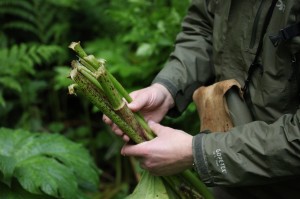http://missoulian.com/news/local/article_b4b3ee9c-a04e-11df-8a72-001cc4c03286.html
GBOP
Hibernating Bears Have Healthy Hearts
Interagency Teams To Search For North Cascades Grizzlies
FOR IMMEDIATE RELEASE
WENATCHEE—Teams of wildlife biologists will begin an effort this month to genetically identify grizzly bears in the North Cascades and determine the extent of their range.
U.S. Forest Service, U.S. Fish and Wildlife Service, Washington Department of Fish and Wildlife, and Western Transportation Institute biologists will complete the study using remote-controlled cameras and hair snares at more than 75 sites spread across about 9,500 square miles in North Central Washington.
The study could be extended another two years depending upon funding, which is being provided by the U.S. Fish and Wildlife Service and U.S. Forest Service.
The North Cascades recovery area includes one of the largest contiguous blocks of federal land in the lower 48 states, stretching from the Canadian border south to Interstate 90. It encompasses the Okanogan-Wenatchee National Forest, Mt. Baker-Snoqualmie National Forest and North Cascades National Park. Much of it lies in rugged, remote country such as the Pasayten, Alpine Lakes and Glacier Peak Wilderness Areas.
Scientists with the North Cascades Interagency Grizzly Bear Technical Team will select study sites based upon knowledge of quality grizzly habitat, accessibility to remote sites and frequency of reputable sightings.
The last confirmed sighting in the area occurred in 1996 in the Glacier Peak Wilderness Area. The current status and distribution of grizzly bears in the North Cascades has not been surveyed for several years and is one of the objectives of the study.
Another interagency team of scientists completed a smaller search for North Cascades grizzlies in 2000 when they completed a study using hair snares on both sides of the border and documented one grizzly bear in Southern British Columbia.
North Cascades ecosystem grizzlies have been protected in both countries for decades, but the population has not recovered from extremely low numbers. Scientists estimate the international population of North Cascades grizzlies to be less than 25 to 30 animals.
“This analysis is timely because the information will assist future North Cascades grizzly recovery efforts,” said Bill Gaines, Ph.D., an Okanogan-Wenatchee National Forest wildlife biologist who is leading the team with Chris Servheen, Ph.D., the U.S. Fish and Wildlife Service’s grizzly bear recovery coordinator.
Other team leaders include Robert Long, Ph.D., with the Western Transportation Institute at Montana State University, and Washington Department of Fish and Wildlife Biologist Scott Fitkin.
Gaines said detection team members will be working in remote sections of wilderness areas or the North Cascades National Park, primarily away from established trails.
“They’ll have quite a summer, backpacking into remote places for several days at a stretch to check snares and cameras,” he said.
The use of snares to collect hair for DNA sampling has become a widely used and accepted technique in wildlife management, according to Gaines. The snares only snag hair samples and do not harm the animals.
He said DNA analysis can identify individual grizzly bears, determine their sex and even measure stress levels. It is also much safer to conduct research this way, rather than traditional mark and recapture techniques that place scientists and grizzlies in close proximity, Gaines said.
Gaines, Servheen, Long, Fitkin and other experienced wildlife biologists will train and supervise detection team members to ensure data quality control for all hair samples. In addition, all team leaders will be managers with federal agencies.
Team members will also deploy remote cameras at some sites to record visits by grizzlies that do not leave hair on snares.
Biggest Bear Bust…. Ever
If you have ever considered feeding a wild bear, what occurred near Oysterville, Washington this last week will make you think twice! As a result of a couple feeding bears dog food, ten bears had to be removed from the area and five were subsequently killed because they had become too habituated to humans and were considered dangerous. Rich Beausoleil, of Washington Fish and Wildlife, told the Chinook Observer, “this was the worst case I’ve seen in my career.” According to the article:
A record 10 black bears were removed from property about a mile north of Joe Johns Road and on Stackpole where a couple had been feeding bears “up to $4,000 of dog food per year” from information obtained by WDFW. The offending parties “are now cooperating fully” according to WDFW enforcement officer Patrick Anderson, who assisted Beausoleil with removing seven adults and three cubs. WDFW Lt. Dan Chadwick also helped with the operation.
The feeding had been going on for some time, but the problems “exploded” this year, according to many neighbors. Hungry bears use to human contact had knocked a hole in a garage door, destroyed a freezer, and downed a fence on at least three properties.
…Sadly, we believe other people knew of the situation and didn’t report it right away. If they had, we could have intervened and probably could have saved all the bears.”
One of GBOP’s objective is to remind people that while it is exciting and thrilling to see wildlife (at a safe distance!) it is never a good idea to feed them. We go to great lengths to remind homeowners that there are simple steps to take in and around the home that will keep bears and deer wild and people safe. These simple steps include keeping garbage, pet food, and bird feeders out of wildlife’s reach but there are many more you can read on our website under cougar, bear, and wolf safety.
To read the entire Chinook Observer article, click here
Annual GBOP and Woodland Park Zoo Bear Affair event
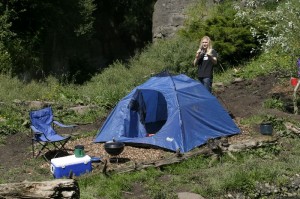
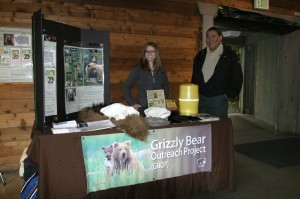
.
………………..
In the morning, the zoo’s two 16-year old brown bears, Keema and Denali were brought out into a mock campsite with food scattered throughout. They both quickly found all the yummy food spread in the tent and stored in the cooler. At one point one of the bears walked right into the tent with its face out one end and its rear end out the other end of the tent. It was a funny sight and the crowd enjoyed watching as the bear eventually leveled the tent and rolled all about with its feet up in the air. It was an eye opener for people to find out what happens when your food is improperly stored at your campsite. For details about storing food properly take a look at our website https://westernwildlife.org/black-bears/tips-for-coexistence/
In the afternoon, the Woodland Park Zoo staff set up a makeshift backyard with table and chairs, barbeque, bird feeder, dog house with dog food inside and garbage cans. Once again, Keema and Denali came out and found all the food. Bears are constantly on the prowl for food and with their keen sense of smell they are drawn into our backyards from a mile away by bird feeders. Julie mentioned that for a bear walking into a backyard and finding a bowl of dog food is like walking into a grocery store. Food that is easily available in our yards is what attracts bears to our neighborhoods, and garbage cans are the number one attractant. Bears can easily smash open a garbage can but a bear resistant garbage can is just that-resistant to bears. In the end, it is up to us to keep food sources away from bears in our neighborhoods. When the food is no longer available the bears will go back to the forests to eat what they are meant to eat-plants, berries and grubs.
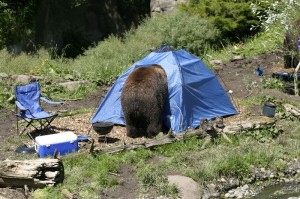
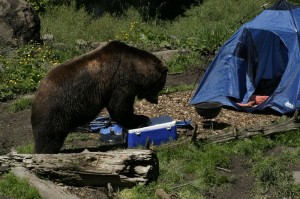
Make sure you don’t miss the Bear Affair and Big Howl for Wolves event in 2011. Check back our events page for the date in June.
For local news coverage on this event and a video clip check out http://greenlake.komonews.com/content/example-what-happens-bear-ly-popular-campsite
Ground breaking – two young grizzlies make it to the Missouri River
http://www.greatfallstribune.com/apps/pbcs.dll/article?AID=20106100303
By KARL PUCKETT • Tribune Staff Writer • June 10, 2010
Two young grizzly bears spotted Tuesday evening near Floweree between Great Falls and Fort Benton probably are the first grizzlies in several decades to make it to the Missouri River, where the bears historically lived, according to Montana Fish, Wildlife & Parks.
Diane Walker, who ranches near Floweree, witnessed the groundbreaking grizzlies.
“They just stopped and looked at us,” said Walker, who was with family when she saw the bears. “They didn’t seem to be frightened or anything.”
The bears were acting playful with each other, she added.
Mike Martin, a FWP game warden captain, said the bears haven’t attacked any livestock or caused other problems.
“But we want people out recreating or living in the area to be observant,” he said.
As of Wednesday evening, the bears still were in the area, according to authorities.
Two young grizzlies have made their way to the Missouri River near Floweree. They are the first two bears in recent history to make it as far as the Missouri. (PHOTO COURTESY RICHARD LOUMA)
Mike Madel, a FWP grizzly bear management specialist, said the agency is monitoring the bears’ movements but will not take any action unless the bears kill livestock.
“They are in a relatively remote stretch of the Missouri between Great Falls and Fort Benton,” he said. “It’s possible they swim the river and get into the Highwood Mountains.”
It also is possible the grizzlies could reach the Charles M. Russell National Wildlife Refuge, which is located on the Missouri River in northcentral Montana.
Last year, a young grizzly traveled 100 miles along the Teton River from the Rocky Mountain Front to Loma, just 1 1/2 miles from the Missouri. But before it reached the big river, it was captured and relocated because it killed sheep.
The grizzlies spotted Tuesday evening at Floweree also traveled the Teton east from the Rocky Mountain Front, Madel said.
Later, the pair was observed traveling in Black Coulee toward the Missouri River. Madel said “it’s very likely” the bears made it to the Missouri, where grizzlies once were common.
That would make them the first grizzlies on the Missouri in recent history, Madel said. When explorers Lewis and Clark traveled through the area in 1804, grizzlies were common on the Missouri River in what is now Great Falls.
“We’re not looking for the grizzly population to move further and further east, but it is occurring naturally,” Madel said.
Eye-witness accounts and physical evidence collected this week confirmed rumors that the grizzlies were on the Teton River north of Great Falls in early June.
Walker said she was at home when her daughter-in- law Shannon Walker, who lives a quarter of a mile away from Diane Walker, called her at 8:30 p.m.
“She said, ‘My God, there’s two grizzlies in front of the hog pen,'” Diane Walker said.
The bears tore one side of the hog pen off, but no hogs were killed, Walker said.
She called the sheriff office, but in the meantime the grizzlies moved out of the hog pen and into a field at the side of the house. Walker, her son J.B. Walker, Shannon Walker and Walker’s sister and brother-in- law watched the bears from the railroad tracks.
“Then they got real playful. They’d stop and bat one another. Then they’d sit down,” she said.
Walker said residents of the area believe grizzlies will be making regular appearances on the prairie each spring.
Bears on the fringes of the core grizzly ecosystem in northcentral Montana are expanding into new areas on all sides, but the development is more dramatic east of the Front because the country there is so open, Madel said.
“Biologically, it’s just a function of population expansion,” he said.
A trend study by FWP concluded that the grizzly population in northcentral Montana is growing by 1 to 3 percent a year.
A study led by the U.S. Geological Survey previously pegged the population in that area at a minimum of 765 bears.
The population work is part of efforts to remove the bear from federal protection, which came in 1975. Madel said a team is developing a conservation strategy that is needed before the bears are considered recovered.
“Obviously, we’ve met the population criteria,” he said.
Young bears are expanding home ranges, learning from sows that are following rivers onto the prairie, Madel said. While the prairie is open, it actually c ontains surprisingly remote and ideal habitat for bears, especially along river drainages, Madel said.
However, much of that remote country also is on private land, which will necessitate FWP working with landowners on prevention measures to reduce conflicts, he said.
It’s green out there!
I headed into the Cascades yesterday to look for bears and was welcomed by a verdant green in every direction. It reminded me why it is that the Pacific Northwest makes such good bear habitat. More than one hundred plant species in the North Cascades of Washington are considered grizzly and black bear foods. Keep an eye out for them in your backyard, and in the backcountry – it’ll help you to start thinking like a bear which makes for a more interesting hike, and also keeps you safer. Here are a selection of shots I thought you might enjoy. Thanks for tuning in!
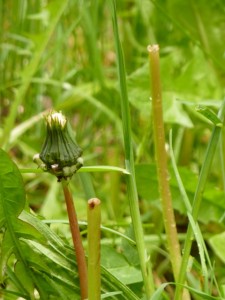

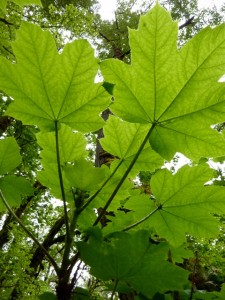
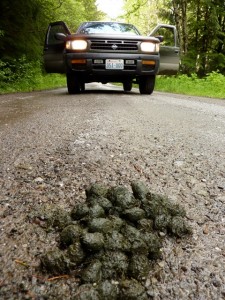
Don’t forget – Bear Affair at Woodland Park Zoo this weekend!
You won’t want to miss this!
Just a friendly reminder that it’s the annual Bear Affair at Woodland Park Zoo this weekend. This event is a real crowd-pleaser! Come and learn first hand why it’s important to store your food and garbage carefully and securely when you’re in the backcountry, or at home in bear country.
Learn first-hand from Grizzly Bear Outreach Field Representative Julie Hopkins on the do’s and don’ts of setting up a safe campsite. As the Zoo’s two 900 pound grizzly bears stumble upon a makes shift campsite, Julie will share how to stay safe in bear country and the role these large carnivores play in the ecosystem.
Sponsored by Brown Bear Car Wash, the event is free with Zoo admission or membership. For more information, visit the Zoo’s website.
Check out how smart this Asiatic Black Bear is….
Fish and Wildlife agents create big scare to protect big bear
By KING5.com and OWEN LEI / KING 5 News — May 16, 2010
MAPLE VALLEY , Wash. – State fish and wildlife experts on Sunday did a “hard release” of a bear that was caught near Maple Valley.
The 400-pound black bear had found a bee hive and showed up in the neighborhood three nights in a row. This time of year bears are waking up and hungry. “They’ll come and get your bird seed, they’ll come in and get your garbage, so it’s time to secure your garbage, it’s time to put your bird feed away,” said Bruce Richards, WSDFW Wildlife agent.
In the past, they would drive the bear way up into the hills and release him there, but this time they tried a new tactic – release the bear where it was captured in hopes that he will get the message that this is not a good place for him.
The hard release involves guns with blanks and soft rounds, noise makers, and a Karelian Bear Dog. “So he associates the barking and the yelling with not wanting to be here,” said Wendy Willette, Department of Fish and Wildlife. This way the bears get to keep living – and do so where they grew up. “It’s fair to the bear,” said Richards.
Last year, using this method, agents released 12 bears and all but one stayed away.
http://www.king5.com/news/local/Fish-and-Wildlife-experts-release-Maple-Valley-bear-93892694.html



